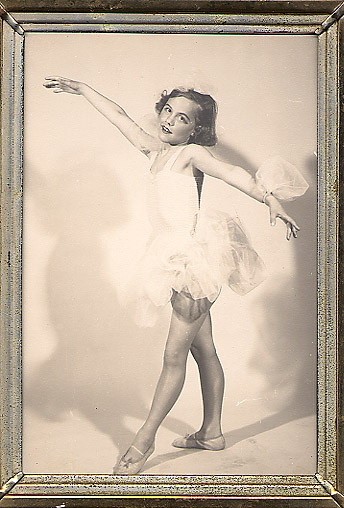
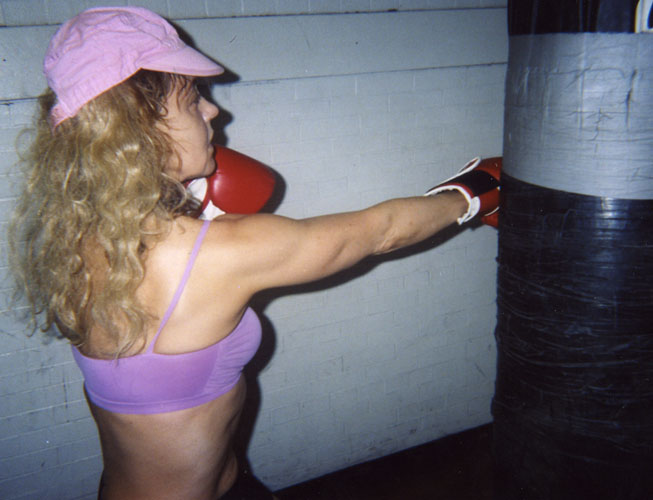
Even if you devote a lifetime to it, especially if you do so, you soon realize that these two art forms, ballet and kickboxing, can never be mastered completely. At times we may execute a perfect punch or pirouette, but as we learn new combinations and choreography, we constantly fall short. As we get older, things may get harder, or ironically easier. I started ballet twenty years ago and kickboxing ten years ago, and while I can no longer take or teach six classes a day every day, my balance and coordination are better. Often we think of fitness in terms of losing weight and gaining strength doing a set of boring exercises or taking classes that require low skill levels, but it is important to have a technique you can return to after injuries or illness, something that is part of your accomplishments, something that teaches you about yourself spiritually and mentally, as well as physically.
An athletic director recently said to me, "You can't put ballet and kickboxing together because one is soft, the other hard." That is the point: to find the yin and yang of movement within the Euroamerican traditions. Actually ballet is deceptively soft, for ballet dancers have backs and butts of steel, and their long, lithesome legs are just as lethal as any kickboxer's. But ballet is turned out and opened up, while kickboxers guard their face with their fists and their torso through rotation and blocks. Contrast the vision of rippling hands and fingers in Swan Lake against the wrapped, gloved fists punching the bag like a weapon. Look at the grand jetes and tour jetes that make a dancer seem like she is flying, against the cutthroat crescents the circle down to slice the opponent. Core strength helps determine how many pirouettes you will do as well as how quickly you can bob and weave out of harm's way. Both ballet and kickboxing are arts that require a long apprenticeship to learn properly, daily training that demands discipline, consistency, and some kind of obedience. As we get older, combining the two is the secret of youth, for ballet dancers can become like overstretched rubber bands and boxers like brittle pieces of armor that crack. Boxing gives a focused speed and precision to the tired dancer, while ballet opens up the boxer's fists, chest, and hips to mitigate injuries. The ballet barre gives flexibility to the boxer's tightened Achilles tendons.
In terms of martial arts, kickboxers fight opponents, while ballet dancers fight and use gravity. Kickboxers benefit from the long balances, adagio, and jump training of ballet, while ballet dancers can release some of their pent-up frustration by engaging in real or imaginary combat. Both require an exquisite sense of rhythm, not only hearing the percussion of the punches and kicks, but manipulating the dynamics of the jumps, turns, pauses, slips, bobs, and weaves from soft to hard to the knockout. In a real fight, we can be so stressed that we lose control. If we have also been trained to push down and pull up like a ballerina, we can use gravity when our lives are at stake. A student of mine, who is doing research on martial arts, feels speed is the deciding factor. While speed is an obvious factor, precise control of space may be even more important--ask any sharpshooter. We can be very musical, but choreographers will never work with us if they don't trust our ability to design exact shapes in space.
At its highest level, KBB is an unattainable art, mastered by a few. However, as a class, everyone can benefit from the basic principles. People with arthritis can do a slow ballet barre in parallel in the water. We can punch the air with a relaxed fist, or knockout a heavy bag. We can do calf raises instead of jumping and focus exercises instead of turning. There is always something to do, even if it is just punching a pillow in a nursing home.
KBB is the interval training, anaerobic class with potentially complex choreography, at least for the land version.
MUSIC: Classical ballet music is best for the land or aquatic barre. Then switch to a percussive slice slice beat like a whip. If you like hip hop, make sure it isn't too bouncy or laid back. Latin and Middle Eastern are too indirect for the direct thrusts--save this music for Knockout Cardio Core:Aerobic-Gut-and-Butt. It's okay to stop and start in this class. The kickboxing combos can be like sprints that hover on the anaerobic threshold.
AQUATIC VERSION
The aquatic version of Knockout Ballet ‘n Box consists of cardio drills of aqua jogging forwards, backwards and sideways, lap swimming with different strokes and a ballet barre with ankle cuffs followed by punches and kicks with core rotation.
Level I performs KBB without resistive equipment to improve range of motion. Kicking and punching are done lightly for a few minutes just to release anger and have fun.
The pool version will definitely improve everyone's technique although the actual movements aren't fighting combos. By attaching the floaties to the ankles as the legs move through the water front, side and back, turned in and turned out, and in sweeping circles, flexibility and strength are improved. Working the legs against the lats and pushing down with the barbells strengthen the port du bras for ballet and the back muscles for kickboxing. Pushing and pulling with the bells strengthen the protraction and retraction for punches.
Levels II and III do as vigorous a water class as they can.
Knockout Ballet 'n Box Aquatic Version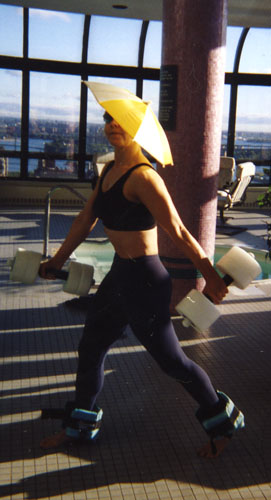
Environment
Knockout Ballet 'n Box is ideally performed in both shallow and deep water. Ideal depth for shallow water is 3.5 to 4.5 feet, where you can do water walking to warm up, a standing ballet barre, kickboxing aerobics, and toning with resistive equipment. Deep water pools are good for the floating ballet barre and cardio kickboxing, provided that you have the core strength to maintain vertical alignment. Naturally the forces of drag, acceleration, leverage, and inertia will be different.The advantage is that if the participant can't do the advanced combinations, they can still get a workout with deep water running. It is best to spend some time in shallow and sometime in deep water in order to take advantage of everything this environment has to offer.
You should wear aqua shoes not only to reduce impact and provide ankle and feet support but to avoid slipping, falling, getting cuts and bruises.
Principles of Water Exercise
Advantages, disadvantages and limitations of water exercise:
Non- or low-impact exercise relieves pressure on joints but does not strengthen bones unless strong resistance is added.
Increases range of motion more than most land exercise but creates a different system of balance, coordination and resistance (buoyancy, wave and drag resistance) from all angles.
Improves cardiovascular conditioning, if aerobic activity is sustained, but does not burn as many calories as land exercise.
Heart rate is lowered but dehydration can occur in the warm water. Water temperature should be between 83-86 F or 28-30C for Knockout Ballet 'n Box. If you are doing a very fast-paced aerobic class, you could exercise at 80-84F. A Level I class can exercise between 84-90F, particularly if you are doing stretching, rehab, slow range of motion exercises, and not too much aerobics. Be careful of hot pools if you are pregnant, have high blood pressure, or are dehydrated. Take off your bathing cap, slow down, and drink plenty of water. If you are getting too cold, work out harder and faster if you can. While you may be able to race laps when the pool temperature is in the seventies Fahrenheit, water classes require temperatures in the eighties. The air should be 3-4 degrees warmer than the water, if possible.
Drag is the water’s resistance to a body moving through it; there are three types of drag--friction, wave drag or turbulence of the water and form drag, how wide and tall your body is. The greater the form drag, the greater the turbulence. Turbulence can push you backwards if you try to swim against the current in the ocean. A broad-shaped object has more drag than a streamlined object which is why swimmers try to streamline their bodies. Frictional drag affects competitive swimmers but not aqua exercisers. The deeper the water the lighter you are so when you are injured you can do more in deep water.
Flotation cuffs on the ankles or wrists provide buoyancy for range of motion exercises, and can make you do things in the water you could never do on land.
Vests and belts are used to maintain buoyancy for the trunk during deep-water arm or leg exercises, for deep-water running or walking and prone- or supine positions to keep you afloat.
And this is the main difference between resisted water exercise and swimming: to win the race you streamline your body and make your strokes as efficient as possible to minimize drag; in aqua exercises you often add resistive equipment to make things hard for yourself, to increase the drag to make you stronger.
In the summer you may be so hot that all you want to do is lie in the pool. Fine.
Start by relaxing and floating around. Hold Aqua barbells while you flex and extend your spine in the rocking horse.
Float on your back holding the barbells.
Bring your knees into your chest.
Push forward on to your stomach.
Bring your knees into your chest.
Push forward on to your back.
The rocking horse targets your core muscles.
Do the Mermaid to work your obliques.
Lie on your side holding the barbells with your legs extended.
Exhale, contract your abs and bring your knees to your chest.
Push over so that you are lying on your other side with your legs extended. Develop a rhythm and increase your speed.
In the vertical position, hold on to the barbells with your arms extended sideways at shoulder level.
Lower your arms until your hands touch your thighs. Resist the raise to the surface. These arm raises work your lats, not your deltoids that much.
Then do some walking, forwards, backwards and sideways, bring it into a light jog wearing an aqua-belt.
Hold on to the side of the pool as if it were a ballet barre and do leg lifts, forwards, backwards, sideways and circular, flexing and pointing your feet. Put floaties on your ankles for added resistance. 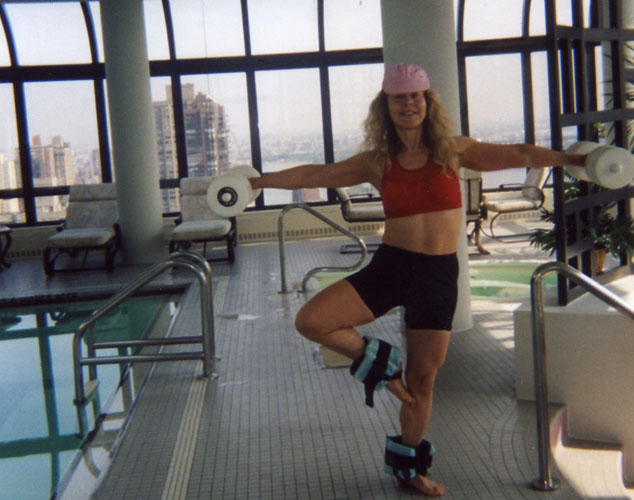 Of course you would be up to your shoulders in the water. I am demonstrating on land to clarify the movements. The water works opposite of the land--it is harder to pull your leg down rather than lift it up; hence it is excellent cross-training for land Ballet 'n Box.
Of course you would be up to your shoulders in the water. I am demonstrating on land to clarify the movements. The water works opposite of the land--it is harder to pull your leg down rather than lift it up; hence it is excellent cross-training for land Ballet 'n Box. Make sure you move your legs in all positions--front, side, circles, and back.
Make sure you move your legs in all positions--front, side, circles, and back.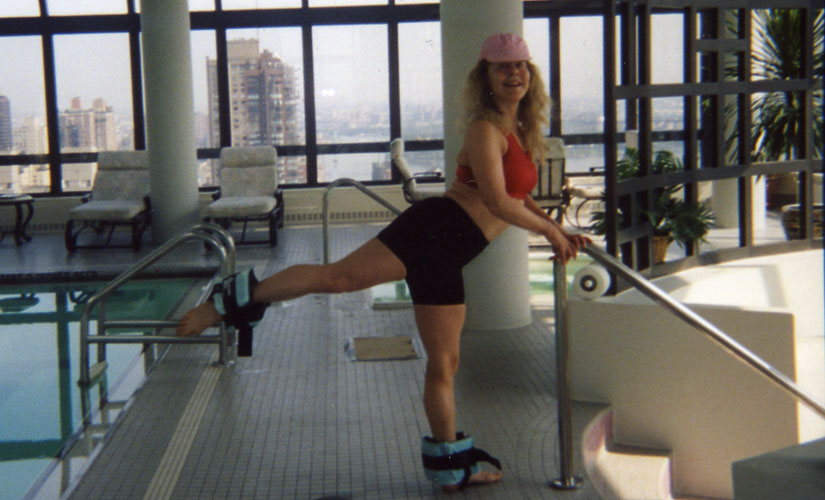
Use the barbells as a port du bras, occasionally lifting and lowering your arms to feel your back muscles working. The lats must perform concentric contractions to lower the barbells and eccentric to control the rise to the surface. Be careful to maintain meticulous alignment so you don't impinge your shoulders. This requires a strong back and rotator cuff. If not, do not use equipment. Note that buoyant equipment requires concentric muscle contraction as you push downwards towards the bottom of the pool, and eccentric muscle control as the equipment rises to the surface. This contrasts with weighted equipment which has the same dynamics as land exercise, although the weight may be lighter in water. Rubberized equipment is similar to land dynamics but water viscosity can make it more challenging.
If you have taken ballet class, you could do things like jumps, chassees, leaps in the pool. Athletes can do bunny hops, single-legged hops and all the plyometric moves that they would do on land.
Then take off the floaties and do another aerobic interval, perhaps laps of your favorite swimming stroke.
Get the hydrobells for the boxing portion or some equipment that increases drag in all directions. You can do front jabs, crosses, cuts and hooks at varying speeds. Note that a clenched fist is LESS intense than an open hand, a webbed glove, or equipment. Level I and II should go at water or half-water tempo; but Level III athletes can use land tempo for speed intervals.
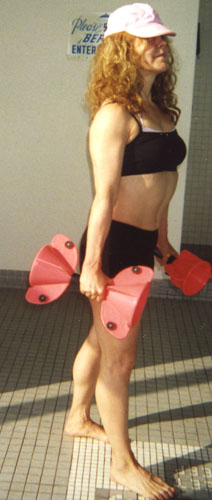
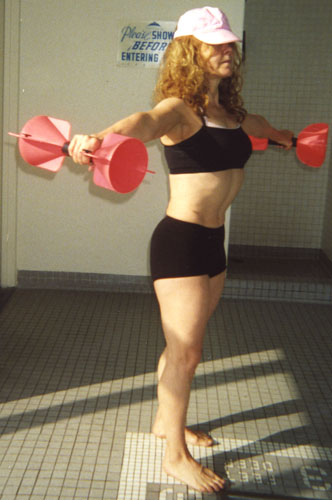 Work the deltoids on the way up, lats on the way down.
Work the deltoids on the way up, lats on the way down.
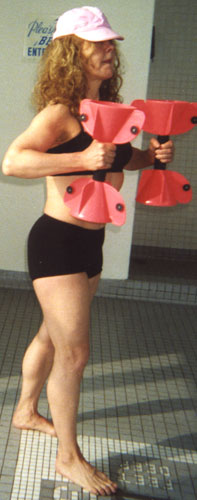
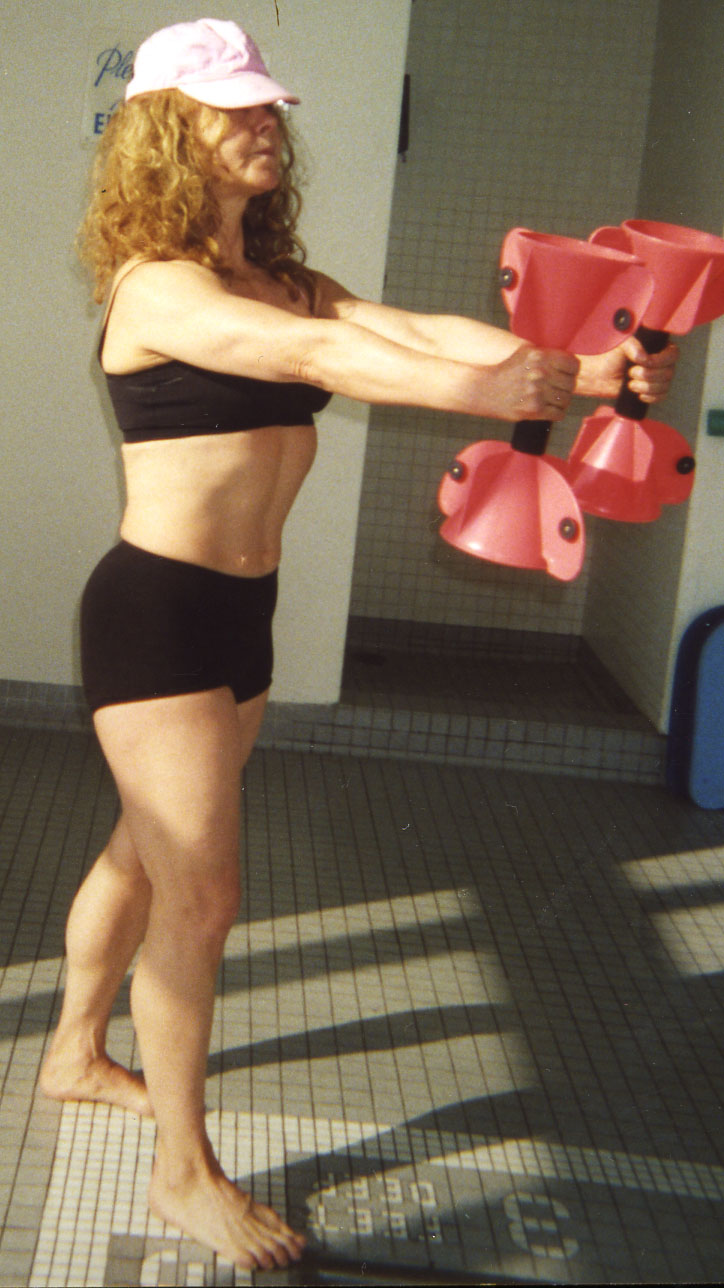 Work protraction and retractions, chest and back muscles.
Work protraction and retractions, chest and back muscles.

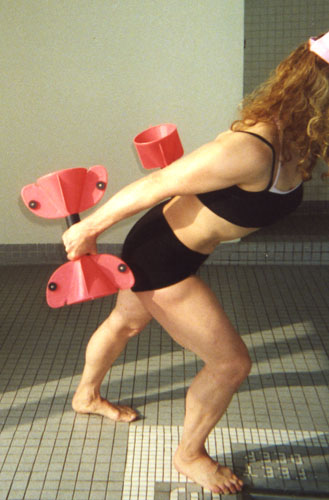 Triceps on the way out, biceps on the way in.
Triceps on the way out, biceps on the way in.

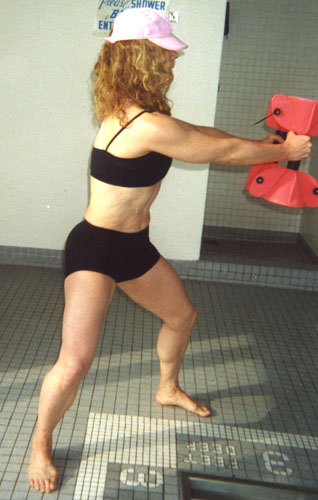 Rotate to left and right, keeping legs firmly planted to strengthen your core muscles and get power for your punches.
Rotate to left and right, keeping legs firmly planted to strengthen your core muscles and get power for your punches.
If it is too difficult with the hydrobells, just use your hands. Do bicep curls as you walk forward and tricep curls as you walk backwards, one of Lisa Bergman’s favorite exercises. Keep your feet firmly planted on the pool floor and your legs separated in a wide squat. Keep your arms straight, holding the hydrobells together. Swing from left to right without moving your torso. Not only will you work your arms but you will feel a great workout in your core muscles.
Ch16: Ballet Float and Cool-Down
Finish as you began--floating, relaxing and stretching in the pool, inside, or outside, enjoying your sultry, sizzling summer.
Level I should do gentle exercises in a warm pool to relax, increase range of motion, tone muscles and increase circulation. Emphasis is on mobilizing all the joints, particularly the rotators of the hips and shoulders and small joints of the hands and feet. Some of these muscles are ignored in the typical gym workout. Exercises are performed standing in shallow water followed and/or preceded by basic deep water aqua jogging for as long a time as can be tolerated.
Aqua belts are used for the jogging, fastened at the waist. Try to use your core muscles to remain vertical rather than in a foetal position.
Aqua barbells that float on the surface can be used to stabilize the core as you do leg exercises, similar to a port du bras in ballet. Then every so often you can strengthen your lats by pushing them down to your sides and up again. Aqua classes should end with stretches, floating and relaxation.
Lisa Bergman, my research assistant, and one of the best aquatics instructors in the country, does many of the punches and kicks slowly so that Level II can feel comfortable.
Swimming Laps
Water Jogging
Water Ballet and Box
Water Ballet Barre
Water Leg Lifts
Water Punches with Resistance
Water Kicks with Resistance
Relax, float and stretch
LAND VERSION
The land version of Knockout Ballet ‘n Box consists of a ballet barre, followed by a center adagio in parallel and turned out, then punch and kick drills, jumps and turns on the sprung floor, and a combination that incorporates punches, kicks, turns and jumps. Or you can put it ballet movements before changing stances, and work in intervals.
The objective is to contrast the slow, smooth, opened-up movements of ballet balance and adagio with the tight, speedy, closed coordination of kickboxing, thereby enhancing the stretch reflex for maximum power, and mastering movement dynamics. More advanced participants should add as many grand battements, jumps, releves, and grand plies as they can stand, as these are the strengthening moves of ballet. While a group fitness version of this class probably will not use the bag, ultimate kickboxing strength is developed through impact, so I demonstrate some of these moves later in this program. Choreography can be created fresh for each class, or you can sample and savor parts or all of the KBB kata. Katas give the student a wide repertory of conditioned responses that they don't have to think about, something that can come in handy in a real fight, and be an excellent way of conditioning otherwise.
This class was initially created for my friend who is a great boxer and kickboxing teacher. I wanted to find a way to protect his neck, open his chest, release his hands and fingers, stretch his legs, and strengthen his feet, in order to rehab or prevent injuries from kickboxing. Yin and yang--by doing the opposite of what you should be doing, you can actually strengthen your performance. A boxing fist that can release into Swan Lake finger ripples is one that will last much longer.
Level I
Do a few minutes of slow ballet barre in parallel and slightly turned out to strengthen lower legs and improve balance. Punching and kicking on land is contraindicated for this group.
Level II
A simplified ballet barre, punching and kicking drills are fine. But a simple combo would be necessary with just a few jumps and no turns.
Level III
On land, KBB could culminate in an actual fighting combination applicable to real combat, something that could be used in stunts.
Knockout Ballet 'n Box can evolve into a Western martial art.
The Western MindBody Experience
Why are Eastern martial arts like Karate, Tai Chi, Kung Fu, Tae Kwon Do et al. considered "spiritual," while Western fighting techniques are compared to slashing meat, the gratuitous violence of gladiator sports, or fake performance art? What does it take to make fighting spiritual? Westerners who seek a "mindbody" experience often turn to the East with a certain nostalgic Orientalism, often confusing the superficial aspects of the rituals with the need to develop, express, and sublimate aggression into power, speed, and grace. What is the difference between a martial artist and a fighter? "Martial" is sometimes defined as warlike, implying a simile for war, rather than the real thing, and martial arts called rituals, choreography that reflects the deeper communal and religious aspects of the experience. The word "martial" comes from Mars, the Roman god of war. Boxing, wrestling, and pankration (Greek MMA) were born during the Olympic festivals in Classical Greece, at the same time the groundwork was laid for drama, rhetoric, and science. Sculpture and vase painting show us that these ancient arts with their concomitant training were similar to our sports today, but the athletes and the intellectuals were equally respected, as there was no mindbody duality --the spirit was willing, and the flesh was strong. But isn't it time for Westerners to seek spirituality in their own cultural roots and athletic competitions?
When we fight, we wrestle with and against our gods, our higher and lower selves, and gravity, as well as our opponent. In ancient times, martial arts were usually part of military training; twenty-first century warfare uses high tech weaponry, and even in street fighting, most soldiers carry guns. But martial arts training will never become outdated because all kinds of people of all ages and backgrounds turn to martial arts for their cathartic effect--the opportunity to release anger, rage, fear, frustration, unbridled lust, and the other negative emotions of our shadows in a dance that empowers us. In that sense, a martial art is a metaphor, the way Shakespeare couched the violence in his plays in beautiful poetry to make the audience reflect on death and destruction, rather than be consumed or intimidated by them. But it is also very real, as those of us know who have been forced to fight for real in self-defense.
No matter what the cultural background, martial artists and fighters risk injury and even death, so this Promethean flame must be lit with responsibility, discipline, knowledge, humility, and wisdom. We need fire just as we need our aggression, so when you rein in negativity, it is only to condense it into a more powerful, hopefully positive explosion.
Asian martial arts usually have a hierarchical system, which necessitates a childlike obedience to the sensei. While SpeedFighting is supervised by accomplished instructors, it is a martial art that empowers the student rather than fostering Oedipal transfers to authority figures. The Greeks often fought to the accompaniment of the lute, and Knockout Ballet 'n Box will sometimes use different kinds of music to enhance rhythmic precision, phrasing, and flow. For years Westerners conquered nature to construct and manufacture their civilizations, rather than seeking to live in harmony with it. Martial artists who want to fulfill their mindbody potential draw energy from nature as in the EvergreenEnergy system of thirteen energy centers from nature (earth, rock, water, laughter, fire, air, trees, taste, smell, eye, brain, aura, shadow) that respond to different movement qualities. Even if you want your fighting to be sharp and fast, you must train your body with the full repertory of dynamics in order to develop the strongest, most supple instrument possible.
The character transformation that occurs during the study of this mindbody discipline can carry over into other aspects of your life so that you face all challenges with courage, discipline, strength, knowledge, and a humility that allows you to transcend the difficulties of the experience, even as you stay in the present.
Ch17: Ballet Barre and Adagio
In spite of its flowery French names, ballet is a simple technique that progresses from knee bends to pointed feet to higher and higher legs, elevated front, side and back, lifting and lowering at various speeds and dynamics, with the legs straight or bent. Then you do balances without the barre, turns, jumps and combinations. It is the choreography that makes it look complex but the technique is simple. Same with kickboxing.
Ballet 'n Box begins with plies, tendus, degages, ronds de jambes, and balances for developes, turned out and in parallel. This takes about fifteen minutes. Slide your whole foot along the floor, pressing so hard into the floor that you strengthen your feet muscles as you point and take it off the floor. Tendus are like scrubbing the floor.Then the aerobics starts with faster punching, jumping, kicking and turning. It is not that you do a full ballet class. You don't do frappes, pirouettes, chaines, balances or those moves. Also it is fluid. There is no stop and start.
It is strange that expressive and/or aesthetic movement such as dance, ballet, martial artists, figure skating involve lateral actions not normally used in everyday life.
The rest of our moving lives are spend sitting, lying, standing or walking straight forwards. We only move sideways when we want to express
ourselves.
Posture: In a real fight, a boxer puts his chin to the chest and deliberately rounds his shoulders. Don’t do this as you slide and strike. Try to maintain good neck alignment and squeeze lats to retract, opening chest.
Impact
Impact in kickboxing is the bag or body deformation that occurs when you strike or kick. Impact on the floor is vertical deformation. Your bag can be light and bouncy like this kid's bag, or hard and heavy like this advanced punching bag.
If you are doing any regular jumping exercises on one leg or both, you should have a wood or comparable floor surface in conjunction with a subfloor system that eliminates dead spots and provides for adequate absorption. There are many ways to do this with spring systems, floating floors, resilient rubber padding and wood furring strips. The standards for athletic floors state there should be a minimum of 50% shock absorption, 2.3 mm standard vertical deformation and 90% ball deflection, 15% maximum deflective indentation, sliding characteristics between 0.5 and 0.7, and a rolling load of 337.6 lb. Very few people have this type of floor at home so that should save their impact for the grass or the trampoline, practice moves at home, but save the complex choreography for their studios or gyms.
Floors have different sliding characteristics. Use of a step on gripping carpet, treaded surface, or sticky floor is better than smooth wood, but dance-based classes require a smooth surface for sliding and turning. Sliding and shuffling-type moves on a sticky floor or carpet can lead to tripping, resulting in twisted ankles, or tendonitis, from the grinding torsion. Floor stretches are more comfortable on a thick carpet or mat. So we can recommend the Slide, the Step, the mini-trampoline, the grass, your smooth wood floor, and a trip to that professional dance studio for complex choreography.
Kicking technique: Don’t get mad except in practice. If you have to fight for real, stay calm, cool and focused.
I will describe roundhouse, front, offensive front, side, spinning back and back kicks as well as inside and outside crescents, the six punches and slip right, slip left and a u that is bob and weave.
Performance
Use a light, fast but relaxed effort as you spar. Only tighten your muscles a few seconds before impact.
Keep wrist neutral as you punch, the same alignment you should have when typing at the computer.
Jabs are fast, light and frequent.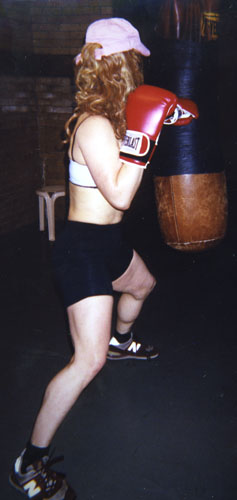
Crosses are strong and powerful-the knockout. Left foot is in front. Shift right side of body forward. Extend right arm pivoting on the ball of the right foot. Drive from rear to front as right shoulder rotates forward. Snap right fist out to bag or pillow in a horizontal motion. Recoil and rotate back to starting position.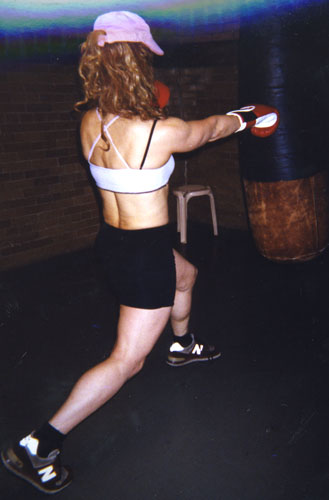
 Extend your arms but don't hyperextend your elbows. It looks like I am missing the punch by hitting the side of the bag, but that is just to show the direction of the cross. In a real fight, you always hit your target. :)
Extend your arms but don't hyperextend your elbows. It looks like I am missing the punch by hitting the side of the bag, but that is just to show the direction of the cross. In a real fight, you always hit your target. :)
Hooks can be driven across the chin, or low to body. A hook is an inside power punch. Pivot left foot and roate torso sharply to the right, like a gate swinging around its hinges. Bend left arm at ninety degrees, fire left forearm parallel to the floor.
Long, 8-10 inches, medium 4-6 inches and up-close ranges an elbow’s length away. In this photo I am doing a right hook. Always do this series of punches on the opposite side when practicing to avoid muscle imbalance. 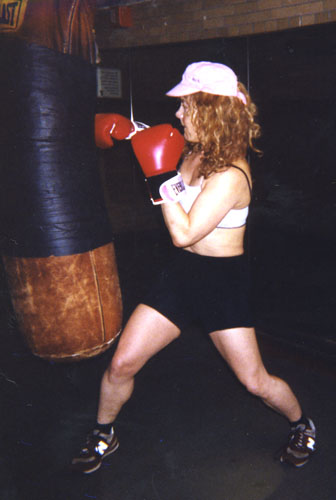
Accelerate, snap, but always recover.
Puke: Think of your bag or pillow as the person, thing or idea that most irritates you so you have some motive to hit it. It could be your shadow-lesser, negative versions of yourself.
If you want to box your partner try this exercise: Acknowledge your shadows to each other. For example, Mary's shadow may be depression that leads to low self-esteem, and Martin's shadow may be fear and frustration leading to rage. Discuss these shadows with each other, then personify them, giving them a shape, sound, smell, taste, texture, and movement. Face each other and begin to box, but instead of actually hitting each other, imagine that you are killing the shadow you hate in the other person. This way you develop your reflexes but no one gets hurt. You can still practice impact on the bag but not on a person. Of course in a real fight, if someone wants to kill you, you must defend yourself. But on a deeper level, it is always someone's shadow that is the evil force. If you can find a way to appeal to the person, and wipe out their shadow, you may be able to kill with kindness and save a lot of bloodshed. Martial arts is an art that trains our mindbodyspirit for the ultimate performance, which is a life-or-death fight. That doesn't mean we have to hurt others or ourselves getting in shape for it.
Uppercuts
Bend at the knees and explode upwards, using your pelvis as a lever, hence the word upper cut. Drive these punches from the hip without winding up.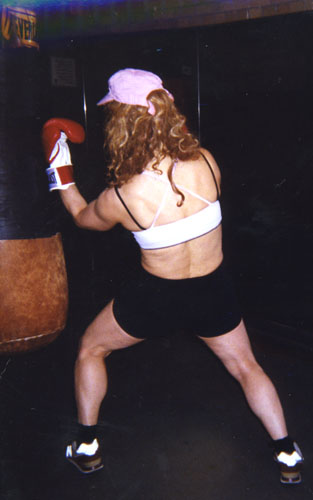
 Notice how the biceps muscle contracts strongly a second before impact.
Notice how the biceps muscle contracts strongly a second before impact.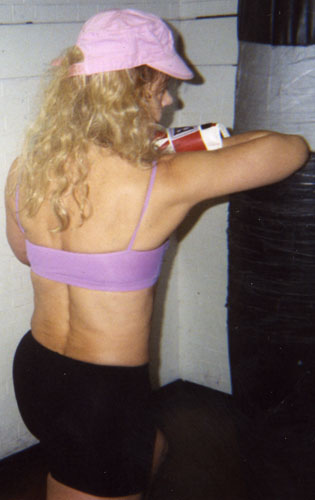 Elbows are powerful weapons, particularly when accompanied by a strong swing of the torso.
Elbows are powerful weapons, particularly when accompanied by a strong swing of the torso.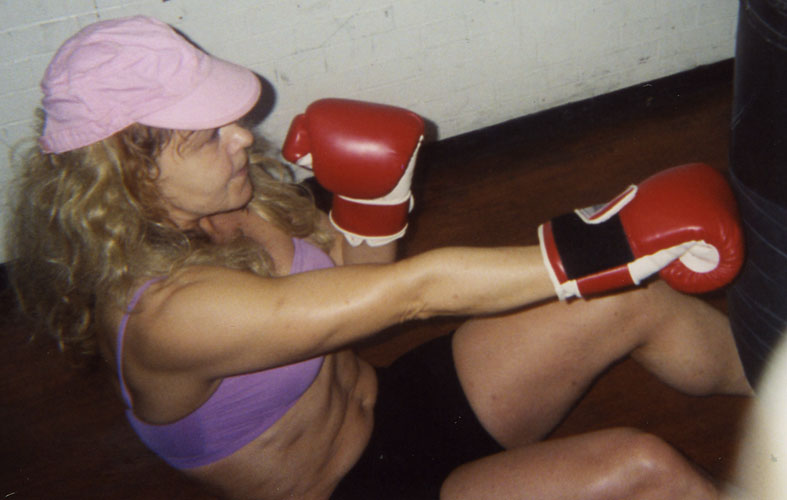 Take breaks to crunch and punch, reminding yourself that the power of the punch comes from the core muscles.
Take breaks to crunch and punch, reminding yourself that the power of the punch comes from the core muscles.
Corkscrew punches have a twist at the last minute clockwise or counterclockwise, usually ending with the palm facing downward.
Spinning back fist: Turn backwards. Lead with right shoulder. Whip arm into horizontal position with fist vertical.
Front elbow strike is thrown like a hook but the arm is bent completely and the elbow, not the fist, is the weapon, which means you must be very close to the target.
Kickboxing is about rotation of the torso.
Stay loose and tighten a few seconds before impact. Hit the bag sharply dead center as it swings into your punch. Use hooks when it swings laterally.
Pain
Kicks are not for everyone. If you have or had any knee or hip pain, or you just don't feel coordinated, stop at the chamber and do knee lifts.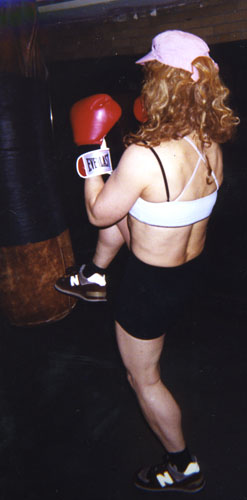 Front snap kick: From a left horse stance, bring up the right knee to the chest. Kick out with the ball of the foot.
Front snap kick: From a left horse stance, bring up the right knee to the chest. Kick out with the ball of the foot. 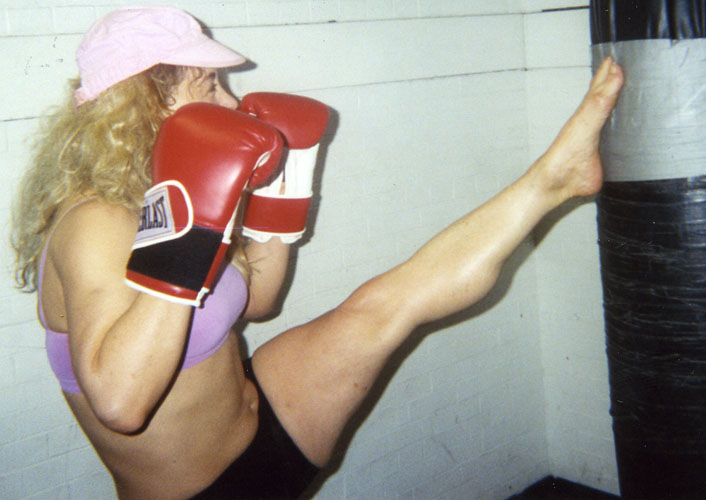 Don’t move the knee as you re-chamber.
Don’t move the knee as you re-chamber. 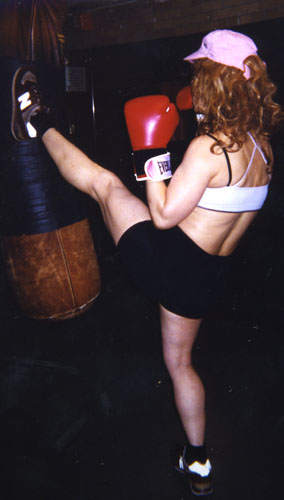
Side kicks can lead from the front or back leg. 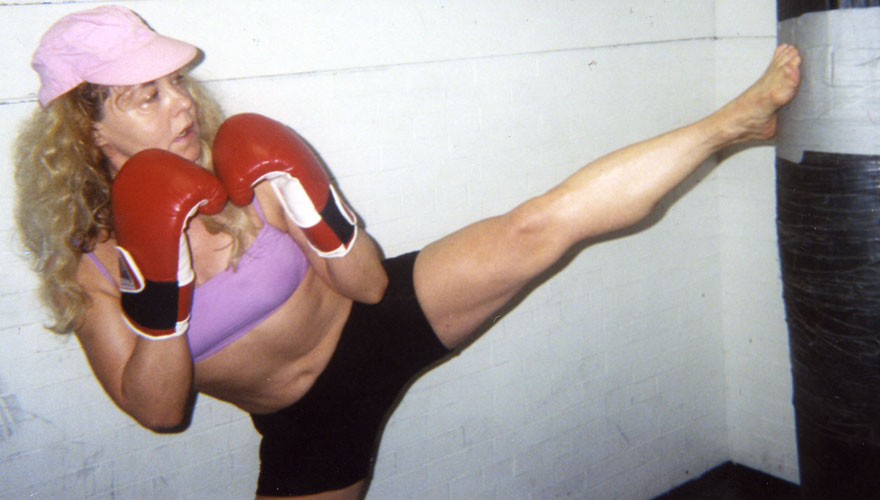 Either kick with the outside of the foot in a knife-edge kick,
Either kick with the outside of the foot in a knife-edge kick, 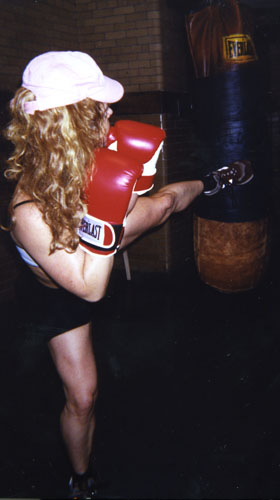 or the front of the foot and shin in a roundhouse.
or the front of the foot and shin in a roundhouse. 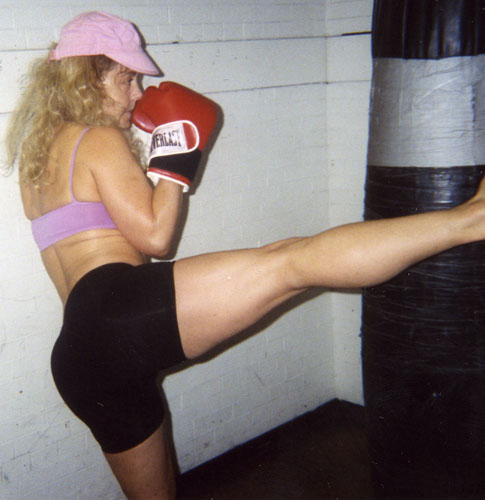
Hit the front shin on a round house, the ball of the foot on a front kick, the side on a knife edge, the heel on a back kick.
Pain: However don’t hit or kick so hard you cause yourself pain. Real fights will test you enough. Don’t be a masochist at home.
Back kicks: Bend over so your chest is parallel to the ground and your head is away from the bag. Chamber your kicking leg and glance over your shoulder. Shoot your heel out as straight as an arrow. Once the kick hits the bag, pull it back in by contracting your hamstrings. 
Crescent Kicks
Warm up with knee circles. If you have back or knee problems just don’t do full crescents. Otherwise straighten the right leg and throw it to the right corner. Circle it up and around to the left corner where it slams back down to the floor.
Clockwise crescents hit the target with the outside of the foot; counterclockwise crescents with the inside of the foot. 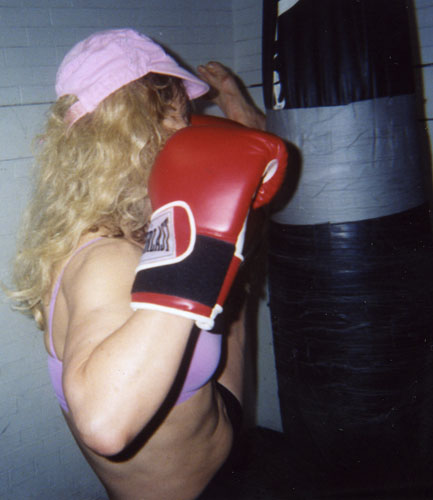 When you swing the leg this high to hit hard, your balance on your standing leg must be excellent or you will be thrown.
When you swing the leg this high to hit hard, your balance on your standing leg must be excellent or you will be thrown.
Box lesser versions of yourselves. Turn off the lights and let your reflection bounce on the walls. Then punch and kick it, not the wall, but the elusive shadow that would sabotage your better self.
Impact can increase strength, reflexes and resilence but it can also damage joints. There is a balance between stress, recovery, strengthening, stretching and stress.
Puke: When throwing kicks and punches you can pretend you are puking out your anger. Don’t do this in real fighting because that requires a cool head. But anger can energize a workout at home.
Ch19: Choreography and Cool-down
The land version of Knockout Ballet ‘n Box® is an aerobic/anaerobic, highly skilled workout for Level III, beginning with a turned-out and parallel ballet barre and adagio, then proceeding to punching and kicking drills, ballet and martial artists’ jumps, and finally kickboxing choreography that uses all the kicks, punches, turns, and jumps in one knockout combo. Knockout Ballet 'n Box is a technique class that balances, stretches, and opens you up with ballet exercise before you close in for the knockout with complex kickboxing technique. This anaerobic/aerobic class is best done in ballet slippers or martial arts shoes as it includes jumps and turns as well as a ballet barre. The principles are to combine the turned-out, open, spacious movements of ballet with the closed-in, fast, moves of kickboxing, not only to cross-train, but to enhance the stretch reflexes so there is more power in the knockout. By beginning with a ballet barre, on land or in the water, the Range Of Motion is increased for kickboxing. The cardiorespiratory training is intermittent, going from a slow heart rate in the barre to anaerobic threshold with complex jumping, punching, turning, kicking choreography. Ballet exercises are also used for active recovery.
You'll notice that the fighting technique in the following combos often breaks rules, by doing back kicks with the closest leg, or many moves that are illegal in competition such as striking below the waist, eye gouges, elbows etc. These combos are not designed for full contact with a person, except in self-defense in a dangerous situation. To practice, check form in a mirror, work with music and rhythm, and then beat the s... out of the heavy bag! That way you will become strong and coordinated without hurting anyone or yourself, but be ready for a wicked, lethal fight should a legitimate occasion arise.
NYU Midterm Exam
Memorize as many combos as possible!
All Combos are described from a fighting stance with the feet on a forty-five degree angle from the target, one and a half times hip width, left foot forward, right foot back. Sometimes the stance will change as in Spinning Back Fist, Spinning Crescent, or a traveling Roundhouse. Naturally, all Combos should be reversed to the other side with the right foot forward, left foot back. Each Combo is an 8-count phrase, which can be first broken down as slowly as 118 BPM and can then whip out at 160 BPM. Learn to combine kicks and punches with fast footwork, turns, jumps, and rapid stance changes.
Vocabulary: Jab Cross Cut Hook Corkscrew Spinning Back Fist Elbow Elbow Back
L Slip R Slip Clockwise or Counter-Clockwise Weave, Duck, Bob and Weave
High, Low, Medium, Mirror, Circular and Side Blocks
Front, Shin, Side, Roundhouse, Back, Inside and Outside Crescents, Slam Kicks, Hook Kicks, Compound Kicks, Spinning and Jumping
Combo One
Jab Cross L Slip R Slip R Front Kick JabCross
Combo Two
Hook Hook Cut Hook Jumping L Front Kick Duck, Bob and Weave
Combo Three
R Cut (3) Jab Jab Cross High Block Left Elbow
Combo Four
R Roundhouse (Change Stance) L Roundhouse (Change Stance) Embrace the Tiger (touch the floor with your left hand then jump high), Low R Cross or Eye Jab
Combo Five
Jab L Slip Cross R Slip L Hook Clockwise Weave Duck L Jumping Back Kick R Cross (This is fast and syncopated)
Combo Six
Jab Jab Cross Jab Cross Jab Cross Jab Cross Hook Hook
Combo Seven
Triple L Front Kick R Outside Crescent
Combo Eight
Jab Cross Cross L Slip Hook Hook Cut High Straight Block L Elbow R Elbow (Crossed over each other)
Combo Nine
L Side Kick Circle then Push Block (2)
Combo Ten
R Cut L Cut R Cut L Hook Clockwise Weave Duck R Inside Crescent (Change Stance)
Combo Eleven
L Outside Crescent Cross Jab Cross Jab Cut
Combo Twelve
Jumping R Side Kick Traveling Jab Jab Low then Mirror Block Cross Cross
Combo Thirteen
Jab Cross Hook Cut Corkscrew Spinning Back Fist (Change Stance) L Elbow
Combo Fourteen
L Back Kick (2) L Elbow R Hook L Hook R HookLHookR Hook (get lower and faster with these body hooks)
Combo Fifteen
L Back Kick (2) Spinning R Ouside Crescent (Change Stance)
Combo Sixteen
Jab Cross Jab Cross Jab Cross Jab Cross R Knee (2)
Combo Seventeen
R Front Kick Jumping R Front Kick L Slam
Combo Eighteen
Hook Cross Hook Low Block Mirror Block L Elbow L Knee Jab Jab R Slip
Combo Nineteen
Jab Cross Jab Cross Jab Cross Jab Cross Jab Cross Hook
Combo Twenty
L Elbow R Elbow R Elbow Back L Elbow Back L Shin Kick R Side Kick
Combo Twenty-One
Triple R Side Kick Traveling Jabs (3) Push Block Hook
Combo Twenty-Two
L Inside Crescent Spinning R Back Kick Low Sweep
Combo Twenty-Three
L Chamber L Full Spin Roundhouse R Full Spin Chamber Roundhouse
Combo Twenty-Four
R Cut R Slip R Hook L Cut R Cut L Cut R Cut L Cut
Combo Twenty-Five
R Front Kick L Back Kick Jump R Front Kick L Front Kick
Combo Twenty-Six
Jab Cross R Cut R Slip R Body Hook L Roundhouse
Combo Twenty-Seven
Jab Cross Jab Cross Duck Body Hook Jab
Combo Twenty-Eight
L Slip Cut Hook Cross JabCrossJab Cross
Combo Twenty-Nine
L Outside Crescent R Triple Front Kick
Combo Thirty
R Front Kick LBack Kick LElbowRElbowLElbow(on an upward diagonal)
Combo Thirty-One
Jab Jab Jab Cross Jab Cross Hook Cut
Combo Thirty-Two
R Outside Cresent L Spinning Roundhouse R Sidekick (Full revolution)
Combo Thirty-Three
Jab Cross R Cut R Slip L Slip L Cut R Cut L High Diagonal Block
Combo Thirty-Four
L Elbow R Elbow R Hook Kick L Back Knee L Cross Eye Jab
Combo Thirty-Five
Jab Cross Hook Hook R Side Kick Cross Cross
Combo Thirty-Six
Bob Weave L Cut L Outside Crescent L Overhand Punch
Combo Thirty-Seven
L Inside Crescent R Outside (full circle)
Combo Thirty-Eight
R Whip Fist L Cross R Jab Duck L low Cut R low Cut L low Cross L Cross
Combo Thirty-Nine
Jab Cross Jab Jab Cross Jab Jab Jab Cross Jab Cross Jab Cross
Combo Forty
Jab Cross Cross L Slip R Slip
Combo Forty-One
Jab Cross Hook Jab Cross Hook Hook
Combo Forty-Two
Jab Cross Hook Cut Jab Jab Cross
Combo Forty-Three
Hook Cut Hook Cross Cross Bob and Weave
Combo Forty-Four
L Cut R Cut L Cut R Cut L Cut R Cut
Combo Forty-Five
4 Body Hooks LRLR L low Cut R low Cut L low Cross R low Cross
Combo Forty-Six
Jab Cross Hook Cut R Cut L Body Hook R Body Hook L Low Cut R Low Cut
Combo Forty-Seven
Low Cross Cross ( Change Stance) L Whipping Fist R Spinning Fist R Front Kick L Back Kick
Combos Forty-Eight to Fifty-Five
Repeat Combos Thirty-Nine to Forty-Seven on the opposite side to change stance back again.
Combo Fifty-Six
Triple R Front Kick Triple L Back Kick
Combo Fifty-Seven
R Front Kick L Back Kick R Front Kick
Combo Fifty-Eight
L Back Kick R Front Kick L Back Kick
Combo Fifty-Nine
Squat R Front Roundhouse (twice)
Combo Sixty
L Shin Kick R Side Kick
Combo Sixty-One
L Shin Kick Double R Side Kick
Combo Sixty-Two
R Knee Outside Crescent L Knee Outside Crescent
Combo Sixty-Three
R Outside Crescent L Outside Crescent
Combo Sixty-Four
L Back Roundhouse R Spinning Back Hook Kick L Full Spin Roundhouse
Combo Sixty-Five
R Hook (2) L Slip L Cross Jab Cross Jab
Combo Sixty-Six
R Front Kick Jumping R Front Kick
Combo Sixty-Seven
L Side Kick R Spinning Back Kick
Combo Sixty-Eight
L Upper Cut (2) R Upper Cut R Slip R Elbow L Elbow L Slip Cross
Combo Sixty-Nine
Rapid Fire Groin Kicks R Roundhouse R Front Kick (optional twice, in a syncopated rhythm) R Low Upper Cut to Groin L Low Upper Cut to Groin R Hook L Body Hook
Combo Seventy
R Double Side Kick to Knee and then Hip, put foot down and R Roundhouse R Back Fist L Double Cross L Knee
Combo Seventy-One
R Low Cut (2) R Elbow L Push Block R Eye Gouge
Combo Seventy-Two
R Outside Crescent L Shin Kick R Side Kick
Combo Seventy-Three
Four Alternating Double Fists with palms facing each other Jab Cross Slip Hook
Combo Seventy-Four
Hook Slip Cut Cut Cut Body Hook Low Cross Cross Elbow
Combo Seventy-Five
2 Chambers and Front Roundhouses
Combo Seventy-Six
Back Lunge with Double High Block Back Knee Jab Cross Jab Cross (syncopated)
Now you are ready to repeat the entire sequence with the right leg front.
This Web site is just a teaser. For detailed choreography and instructional manuals, contact julia.keefer@nyu.edu.
KNOCKOUT CARDIO-CORE with AEROBIC GUT AND BUTT
Dr. Keefer's Corrective Clinic